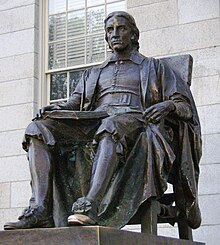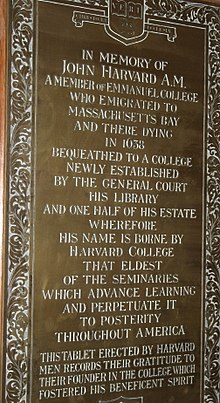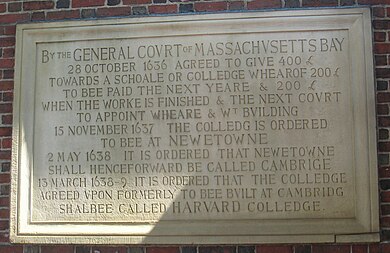John Harvard (clergyman)
John Harvard | |
|---|---|
 | |
| Born | 29 November 1607 (baptised)[1] |
| Died | 14 September 1638 (aged 30) |
| Cause of death | Tuberculosis |
| Alma mater | Emmanuel College, Cambridge |
| Occupation | Pastor |
| Known for | A founder of Harvard College |
| Spouse | Ann Sadler |
| Children | None |
| Signature | |
John Harvard (1607–1638) was an English minister in Colonial America whose deathbed[2] bequest to the "schoale or Colledge" founded two years earlier by the Massachusetts Bay Colony was so gratefully received that it was consequently ordered "that the Colledge agreed upon formerly to bee built at Cambridg shalbee called Harvard Colledge."[3] Harvard University considers him the most honored of its founders—those whose efforts and contributions in its early days "ensure[d] its permanence"—and a statue in his honor is a prominent feature of Harvard Yard.
Life
Early life

Harvard was born and raised in Southwark, Surrey, England, (now part of London), the fourth of nine children of Robert Harvard (1562–1625), a butcher and tavern owner, and his wife Katherine Rogers (1584–1635), a native of Stratford-upon-Avon. Her father, Thomas Rogers (1540–1611), served on the borough corporation's council with John Shakespeare.[citation needed] Harvard was baptised in St Saviour's Church (now Southwark Cathedral)[4] and attended St Saviour's Grammar School, where his father was a member of the governing body and a warden of the parish church. His grandparents' house in Stratford-upon-Avon, largely rebuilt after a fire of 1595, survives as 'Harvard House'.[5]
In 1625, bubonic plague reduced the immediate family to only John, his brother Thomas, and their mother. Katherine was soon remarried—firstly in 1626 to John Elletson (1580–1626), who died within a few months, then (1627) to Richard Yearwood (1580–1632). She died in 1635, Thomas in 1637.
Left with some property, Harvard's mother was able to send him to the University of Cambridge,[6] He was admitted as a pensioner to Emmanuel College, Cambridge on 19 December 1627; he was awarded his B.A. in 1632 and M.A. in 1635.[7] He was subsequently ordained a dissenting minister.[8][better source needed]
Marriage and career
On 19 April of either 1636 or 1637, Harvard married Ann Sadler (1614–55) of Ringmer in Sussex, sister of his college contemporary John Sadler, at St Michael the Archangel Church, in the parish of South Malling, Lewes.[7][9][better source needed]
In the spring or summer of 1637, the couple emigrated to New England, where Harvard became a freeman of Massachusetts[6] and, settling in Charlestown, a teaching elder of the First Church there[10] and an assistant preacher.[8] In 1638, a tract of land was deeded[clarification needed] to him there, and he was appointed that same year to a committee "to consider of some things tending toward a body of laws."[6][clarification needed]
He built his house on Country Road (later Market Street and now Main Street), next to Gravel Lane, a site that is now John Harvard Mall. His orchard extended up the hill behind his house.[11]
Death
On 14 September 1638, Harvard died of tuberculosis and was buried at Charlestown's Phipps Street Burying Ground. In 1828, Harvard University alumni erected a granite monument to his memory there,[6][12] his original stone having disappeared during the American Revolution.[10]
Harvard's widow, Ann, is thought to have married Thomas Allen, his successor as the teacher of the Charlestown church. Allen acted as administrator in the execution of Harvard's estate and paid his bequests.[13]
Founder of Harvard College


Two years before Harvard's death the Great and General Court of the Massachusetts Bay Colony—desiring to "advance learning and perpetuate it to posterity: dreading to leave an illiterate ministry to the churches, when our present ministers shall lie in the dust"—appropriated £400 toward a "schoale or colledge"[3] at what was then called Newtowne.[14] In an oral will spoken to his wife[15] the childless Harvard, who had inherited considerable sums from his father, mother, and brother,[16] bequeathed to the school £780—half of his monetary estate—with the remainder to his wife.[4] This bequest was roughly equal to the Massachusetts Bay Colony's annual tax receipts.[17]
Perhaps more importantly[18] he also gave his scholar's library comprising some 329 titles (totaling 400 volumes, some titles being multivolume works).[19]: 192 In gratitude, it was subsequently ordered "that the Colledge agreed upon formerly to bee built at Cambridg shalbee called Harvard Colledge." [3] (Even before Harvard's death, Newtowne had been renamed[3] Cambridge, after the English university attended by many early colonists, including Harvard himself.)[20]
Founding "myth"
"Smartass" tourguides[21][22] and the Harvard College undergraduate newspaper, The Harvard Crimson,[23] commonly assert that John Harvard does not merit the honorific founder, because the Colony's vote had come two years prior to Harvard's bequest. But as detailed in a 1934 letter by Jerome Davis Greene, Secretary of the Harvard Corporation, the founding of Harvard College was not the act of one but the work of many; John Harvard is therefore considered not the founder, but rather a founder,[24][25] of the school—though the timeliness and generosity of his contribution have made him the most honored of these:
The quibble over the question whether John Harvard was entitled to be called the Founder of Harvard College seems to me one of the least profitable. The destruction of myths is a legitimate sport, but its only justification is the establishment of truth in place of error.
If the founding of a university must be dated to a split second of time, then the founding of Harvard should perhaps be fixed by the fall of the president's gavel in announcing the passage of the vote of 28 October, 1636. But if the founding is to be regarded as a process rather than as a single event [then John Harvard, by virtue of his bequest "at the very threshold of the College's existence and going further than any other contribution made up to that time to ensure its permanence"] is clearly entitled to be considered a founder. The General Court ... acknowledged the fact by bestowing his name on the College. This was almost two years before the first President took office and four years before the first students were graduated.
These are all familiar facts and it is well that they should be understood by the sons of Harvard. There is no myth to be destroyed.[26]
Memorials and tributes
A statue in Harvard's honor—not, however, a 'likeness' of him, there being nothing to indicate what he had looked like[8]—is a prominent feature of Harvard Yard (see John Harvard statue) and was featured on a 1986 stamp, part of the United States Postal Service's Great Americans series.[27] A figure representing him also appears in a stained-glass window in the chapel of Emmanuel College, Cambridge.[8][6]
The John Harvard Library in Southwark, London, is named in Harvard's honor, as is the Harvard Bridge that connects Boston to Cambridge.[28] There is a memorial window in his honor in Southwark Cathedral.[29]
References
- ^ Tedder, Henry Richard (1891). . In Stephen, Leslie; Lee, Sidney (eds.). Dictionary of National Biography. Vol. 25. London: Smith, Elder & Co. pp. 77–78.
- ^ Conrad Edick Wright, John Harvard: Brief life of a Puritan philanthropist Harvard Magazine. January–February 2000. "By the time the Harvards settled in Charlestown John must already have been in failing health ... Consumption kills slowly. By the time Harvard died, he knew what he wanted to do with his estate."
- ^ a b c d Charter of the President and Fellows of Harvard College
- ^ a b Rowston, Guy (2006). Southwark Cathedral – The authorised Guide.
- ^ Historic England. "Harvard House (Grade I) (1298524)". National Heritage List for England. Retrieved 15 March 2020.
- ^ a b c d e Wilson, J. G.; Fiske, J., eds. (1892). . Appletons' Cyclopædia of American Biography. New York: D. Appleton.
- ^ a b "Harvard, John (HRVT627J)". A Cambridge Alumni Database. University of Cambridge.
- ^ a b c d Emmanuel College: John Harvard Retrieved 2012-05-01
- ^ Dean, John Ward. "The New England Historical and Genealogical Register,: Volume 39 1885". Retrieved 4 April 2020.
- ^ a b Melnick, Arseny James. "Celebrating the Life and Times of JOHN HARVARD". Retrieved 20 September 2011.
- ^ Charlestown Historical Society: Full Historic Timeline
- ^ Edward Everett (1850). Orations and speeches on various occasions. Vol. I. Boston: Charles C. Little and James Brown. pp. 185–189.
- ^ J. Savage, A Genealogical Dictionary of the First Settlers of New England, 4 Vols. (Little, Brown & Co., Boston 1860), I, pp. 36-37 (Internet Archive).
- ^ a b New England's First Fruits (1643)
- ^ Callan, Richard L. 100 Dears of Solitude: John Harvard Finishes His First Century. The Harvard Crimson. 28 April 1984. Retrieved 13 October 2012
- ^ The Harvard Graduates' Magazine. Vol. 16. Harvard Graduates' Magazine Association. 1908. Retrieved 12 May 2014.
- ^ Foster, Margery Somers (1962). "Out of smalle beginings..." : An Economic History of Harvard College in the Puritan Period (1636 to 1712). Belknap Press of Harvard University Press. p. 6.
- ^ Alfred C. Potter, "The College Library." Harvard Illustrated Magazine, vol. IV no. 6, March 1903, pp. 105–112.
- ^ Potter, Alfred Claghorn (1913). Catalogue of John Harvard's library. Cambridge: J. Wilson.
- ^ Degler, Carl Neumann (1984). Out of Our Pasts: The Forces That Shaped Modern America. New York: HarperCollins. ISBN 978-0-06-131985-3. Retrieved 20 September 2011.
- ^ Shand-Tucci, Douglas (2001). The Campus Guide: Harvard University. Princeton Architectural Press. pp. 46–​, 51. ISBN 9781568982809.
- ^ Primus V (May–June 1999). "The College Pump. Toes Imperiled". Harvard Magazine.

- ^ "Memorial Society Honors Founder of College In the Name and Image of Two Other Men – College Founded By Grant of the Massachusetts General Court in the Year 1636". Harvard Crimson. 26 November 1934.
When the members of the Memorial Society place a wreath on the statue of John Harvard today, expecting to honor the memory and the image of the founder of Harvard College, they will be honoring the likeness of another man and the name of a man who was not the legal founder of the college.

- ^ Morison, Samuel Eliot (1935). The Founding of Harvard College. p. 210.
John Harvard cannot rightly be called the founder of Harvard College...
- ^ Mather, Cotton (1853). Robbins, Thomas (ed.). Magnalia Christi Americana: Or, The Ecclesiastical History of New-England, from Its First Planting, in the Year 1620, Unto the Year of Our Lord 1698 ... Vol. 2. Hartford: S. Andrus & Son. p. 10.
But that which laid the most significant stone in the foundation, was the last will of Mr. John Harvard ...
- ^ Excerpted from Greene, Jerome Davis (11 December 1934). "Don't Quibble Sybil — The Mail" (Letter to the editor)". Harvard Crimson. ("Don't quibble, Sybil" is a line from Noël Coward's 1930 Private Lives.)
- ^ usstampgallery.com: John Harvard
- ^ Alger, Alpheus B.; Matthews, Nathan Jr. (1892). Harvard Bridge: Boston to Cambridge, March 1892. Boston, Massachusetts: Rockwell and Churchill. p. 14. Retrieved 20 September 2011.
- ^ "John La Farge Stained Glass in New England: A Digital Guide". library.bc.edu.
Further reading
- Rendle, William (1885). John Harvard, St. Saviour's, Southwark, and Harvard University, U.S.A. London: J.C. Francis.
- Shelley, Henry C. (1907). John Harvard and His Times. Boston, MA: Little, Brown, and Co.
External links
- Potter, Alfred Claghorn (1913). Catalogue of John Harvard's library. Cambridge: J. Wilson.
- 1607 births
- 1638 deaths
- 17th-century Calvinist and Reformed Christians
- 17th-century English clergy
- 17th-century American people
- 17th-century deaths from tuberculosis
- Alumni of Emmanuel College, Cambridge
- English Dissenters
- English philanthropists
- Harvard University people
- People educated at St Saviour's Grammar School
- People from Southwark
- Burials in Boston
- University and college founders
- Kingdom of England emigrants to Massachusetts Bay Colony
- 17th-century philanthropists


